Click on images to enlarge

habit in autumn (Photo: Sheldon Navie)
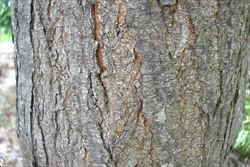
bark on main trunk (Photo: Sheldon Navie)
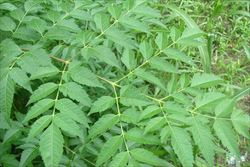
leaf of a juvenile tree, which usually have more deeply-toothed or even slightly lobed leaflets (Photo: Sheldon Navie)
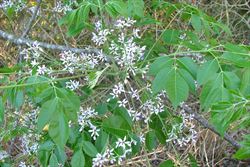
young leaves and flower clusters in spring (Photo: Sheldon Navie)

close-up of flowers (Photo: Sheldon Navie)

immature fruit (Photo: Sheldon Navie)
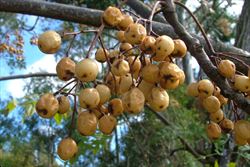
mature fruit (Photo: Sheldon Navie)
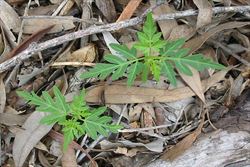
seedlings (Photo: Sheldon Navie)
Scientific Name
Melia azedarach L.
Synonyms
Azedarach sempervirens Kuntze var. australasica (A. Juss.) KuntzeMelia australasica A. Juss.Melia australis Sweet ex G. DonMelia australis SweetMelia azedarach L. var. australasica (A. Juss.) C. DC.Melia composita Willd.Melia dubia Cav.
Family
Meliaceae
Common Names
azedarach, bead tree, berry tree Cape lilac, Cape syringa, China berry, China tree, Chinaball tree, China-berry, Chinaberry, Chinaberry tree, Chinaberrytree, Chinese umbrella, Indian bead tree, Indian lilac, Japanese bead tree, lilac tree, margosa tree, Persian lilac, pride of India, pride-of-India, Sichuan pagoda tree, syringa, syringa berrytree, Texas umbrella tree, tulip cedar, umbrella tree, white cedar
Origin
Native to China, Japan, the Indian sub-continent (i.e. India and Sri Lanka) south-eastern Asia (i.e. Indonesia and Papua New Guinea) and large parts of northern and eastern Australia. In Australia it is native to some parts of northern Western Australia (i.e. the Kimberley region) and the Northern Territory (i.e. the Victoria River district), northern and eastern Queensland, and the coastal districts of northern and central New South Wales (i.e. north from Milton in the Shoalhaven region).
Naturalised Distribution
This species is naturalised beyond its native range in many parts of central and southern Australia (i.e. in inland New South Wales, in Victoria, in some parts of South Australia, in the southern parts of the Northern Territory, and in the south-western and southern parts of Western Australia). It is also naturalised on Lord Howe Island, and probably naturalised on Norfolk Island and Christmas Island.
Widely naturalised in southern Europe, southern Africa (i.e. South Africa and Swaziland), southern USA, Mexico, Central America, the Caribbean, tropical Southern America (i.e. Argentina, Bolivia, Ecuador and Uruguay), Hawaii, the Cook Islands, Fiji, French Polynesia, Nauru, New Caledonia, Niue, Palau, Tonga and the Galápagos Islands.
Notes
White cedar (Melia azedarach) is regarded as an environmental weed in south-eastern Western Australia and the southern parts of the Northern Territory. It is also thought to be a minor environmental weed or potential environmental weed in South Australia, Victoria and those parts of New South Wales that are outside its native range.

